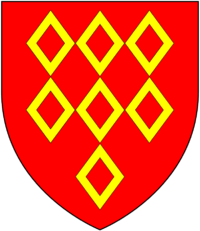Roger de Quincy, 2nd Earl of Winchester

Roger de Quincy, 2nd Earl of Winchester (c.1195 – 25 April 1264[1][2]), Hereditary Constable of Scotland, was an Anglo-Norman nobleman prominent in England and Scotland.
He was the second son and eventual heir of Saer de Quincy, 1st Earl of Winchester by his wife Margaret de Beaumont (died 1235). He bore arms different from his father's.
He probably joined his father on the Fifth Crusade in 1219, where the elder de Quincy fell sick and died. Since his elder brother had died a few years earlier, he inherited his father's titles and estates, though he did not take possession of the estates until February 1221, probably due to his absence on crusade. He did not formally become earl until after the death of his mother in 1235.
De Quincy married three times but produced no male children. His first marriage was to Helen of Galloway (c.1208-1245), the eldest of the three daughters and co-heiress of Alan, Lord of Galloway. Helen's share of her paternal inheritance, which passed to her husband, was the office of Hereditary Constable of Scotland and one-third of the lordship of Galloway. The peerage title of Lord of Galloway, however, went through Helen's half-sister Devorguilla to her husband John Balliol, with part of the de Morville lands in Lauderdale.[3] By Helen of Galloway, de Quincy had three daughters and co-heiresses:
- Helen, who married Alan la Zouche, Lord Zouche of Ashby;
- Elizabeth (or Isabel), who married Alexander Comyn, 2nd Earl of Buchan.
- Margaret (or Margery), who married William de Ferrers, 5th Earl of Derby and was thus stepmother to her own stepmother.
De Quincy's second marriage was in about 1250 to Maud de Bohun (died 1252), daughter of Humphrey de Bohun, 2nd Earl of Hereford, who died two years later. Thirdly in 1252 he married Eleanor de Ferrers, daughter of William de Ferrers, 5th Earl of Derby. Neither of these marriages produced any children.
From his first marriage he inherited the office of Hereditary Constable of Scotland and one-third of the lordship of Galloway, and ruled his portion of Galloway strictly. The Galwegians rebelled under Gille Ruadh, not wanting their land divided, but the rebellion was suppressed by King Alexander II of Scotland. The Galwegians revolted again in 1247, forcing de Quincy to take refuge in a castle. Faced with a siege and little chance of relief, he and a few men fought their way out and rode off to seek help from Alexander, who raised forces to suppress the rebellion. In the following years de Quincy was one of the leaders of the baronial opposition to King Henry III of England, although he fought for Henry against the Welsh in the 1250s and 1260s.
He died without male children and therefore the earldom of Winchester became extinct. His estates were divided between his three daughters and co-heiresses.
References
- ↑
 William Hunt (1896). "Quincy, Saer de". In Lee, Sidney. Dictionary of National Biography. 47. London: Smith, Elder & Co. (Roger de Quincy is a subarticle in his father's article.) His dates are given as 1195?-1265 at the beginning of the subarticle, but his death date is given as 25 April 1264 near the bottom of the page.
William Hunt (1896). "Quincy, Saer de". In Lee, Sidney. Dictionary of National Biography. 47. London: Smith, Elder & Co. (Roger de Quincy is a subarticle in his father's article.) His dates are given as 1195?-1265 at the beginning of the subarticle, but his death date is given as 25 April 1264 near the bottom of the page. - ↑ Cawley, Charles. Medieval Lands: A prosopography of medieval European noble and royal families, "ROGER de Quincy (-25 Apr 1264, bur [Brackley])"
- ↑ Stewart, John, LL.D., and Burnett, George, Lord Lyon, editors, "The Exchequer Rolls of Scotland", vol.1, 1264-1359, Edinburgh, 1878, pps:33 and 45.
Sources
- Grant G. Simpson, “An Anglo-Scottish Baron of the Thirteenth century: the Acts of Roger de Quincy Earl of Winchester and Constable of Scotland” (Unpublished PhD Thesis, Edinburgh 1963).
| Preceded by Saer de Quincy |
Earl of Winchester | Succeeded by Title extinct |